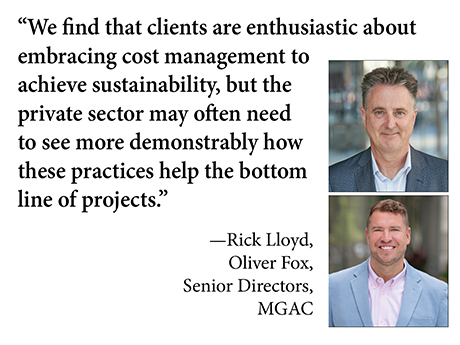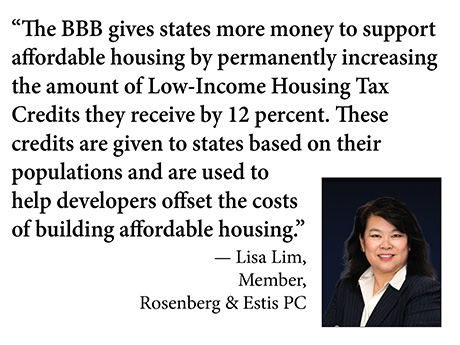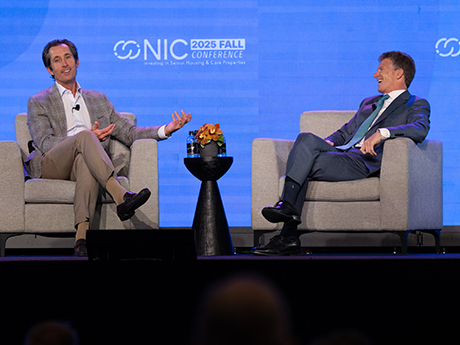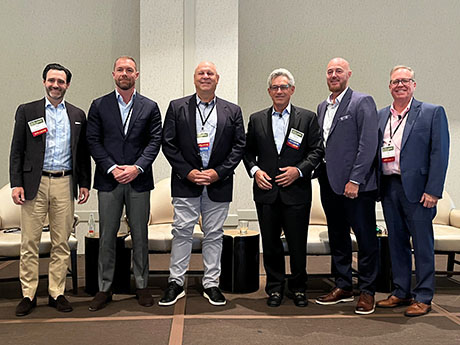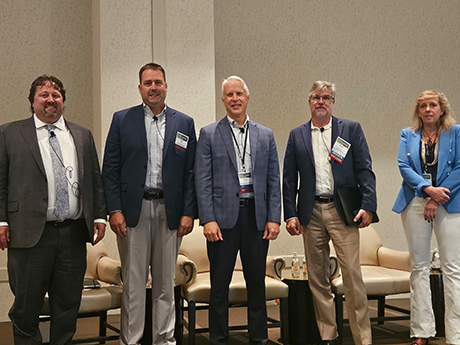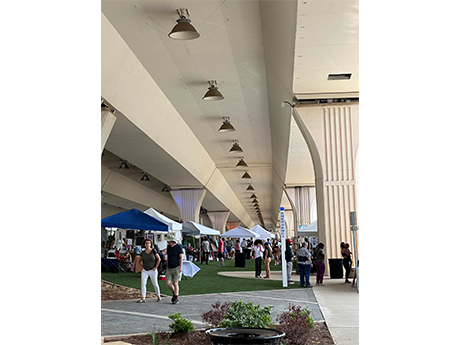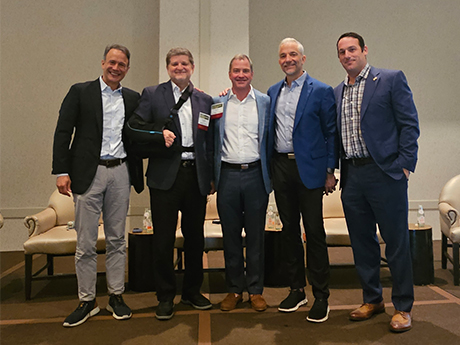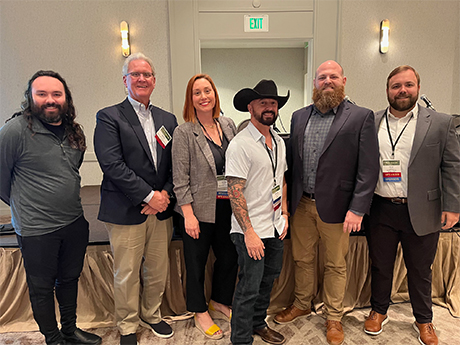By Rick Lloyd and Oliver Fox, senior directors, MGAC The construction industry is used to navigating volatility, even if 2025 has certainly brought a unique lineup of challenges. Persistent inflation, supply chain disruptions, rising material costs, tariffs and skilled labor shortages affect all budgets. More broadly, market uncertainty can make owners, investors and contractors understandably more conservative about cost. At the same time, public and private organizations are under growing pressure to meet ambitious carbon and energy performance mandates. This combination of market conditions has put additional pressures on the role of project cost management, but it has also created opportunities to think more proactively about strategizing costs more efficiently. Ultimately, cost managers can use certain best practices to help ensure more effective project outcomes and mitigate risks. Unlike in Europe and the United Kingdom, where carbon mandates are more consistent and mature, such policies in the United States are less consistent, in part because standards can vary significantly by state or city. Some states, such as California and Massachusetts, have more progressive embodies systems for tracking carbon usage and stricter building performance requirements. Generally, however, U.S. developments and capital projects focus first on project costs, then factor in carbon …
Features
By Lisa Lim, member, real estate & housing specialist, Rosenberg & Estis PC On July 4, 2025, President Trump signed the One Big Beautiful Bill Act (BBB) into law. The legislation represents one of the nation’s most sweeping tax, spending and regulatory shakeups in decades, touching everything from border enforcement to energy. The passing of the bill also marked a significant step in addressing the nation’s worsening housing crisis, as well as the need for community reinvestment. Policymakers have long debated the best ways to incentivize the construction of affordable housing, spur economic development and preserve historic buildings. The BBB was designed, in part, to meet those goals by expanding and permanently extending key federal tax credit programs, including the Low-Income Housing Tax Credit (LIHTC), the New Market Tax Credit (NMTC) and the Historic Tax Credit (HTC). In this article, we address what each of the legislative impacts are for each of those programs and assess their ramifications on the broader U.S. housing market. Low-Income Housing Tax Credits At the most basic level, the BBB gives states more money to support affordable housing by permanently increasing the amount of Low-Income Housing Tax Credits (LIHTCs) they receive by 12 percent. These …
By Sean Slater, senior principal, RDC Architecture & Planning In today’s evolving retail landscape, one of the most promising — and often overlooked — opportunities lies in the land surrounding our nation’s hospitals and medical centers. As healthcare systems continue to expand and consolidate, savvy development executives recognize the immense potential of strategically positioning retail properties in locations that are adjacent to major medical facilities. Doing so combines consistent foot traffic, demographic advantages and an urgent need for community-focused amenities. This was the scenario that RDC’s placemaking design team faced at the Texas Medical Center’s (TMC) new TMC3 research and development campus south of the massive healthcare cluster near downtown Houston. On any given day at that sprawling site, more than 100,000 people — about the seating capacity of the Los Angeles Memorial Coliseum — come to work, while 27,400 patients visit one of the 21 associated hospitals. Many of them are international visitors staying at local hotels with significant downtime. Kristen Kupperman, TMC’s vice president of design, construction and facilities, introduced RDC’s design team to this problem, saying that there are 80,000 women who work at TMC every day, yet there is nowhere to get a manicure and nowhere …
AUSTIN, TEXAS — The Del Webb active adult brand, long associated with Sun Belt markets, is gaining traction in the Midwest, says Ryan Marshall, president and CEO of Atlanta-based PulteGroup Inc. (NYSE: PHM), parent company of Del Webb. But unlike Sun City, Arizona — the pioneering planned retirement community developed by Del Webb starting in 1960 — today’s developments are much smaller in scale. Del Webb Hickory Greens, located about 25 miles southwest of Cleveland in Columbia Township, Ohio, officially opened in March of this year. The 622-home community is spread across 325 acres, where residents age 55 and older can enjoy a variety of resort-style amenities designed to foster an active and social lifestyle. The centerpiece of the community is a 14,000-square-foot amenity center featuring indoor and outdoor pools, outdoor pickleball courts and a fitness center. Del Webb Hickory Greens also offers year-round social events, walking trails, over 170 acres of green space, a dog park and a community garden. “It’s one of our best-selling active adult Del Webb communities year to date,” says Marshall, noting that the Cleveland market is not traditionally known as a hotspot for retirees. “We’ve probably sold 110 homes [at Del Webb Hickory Greens] since February, which is …
By Jake Zwaagstra, CEO, TriCelta Development In many cases, the success or failure of a commercial development can boil down to one thing: trust. While stakeholders can be presented with a neatly packaged plan and broad estimates, a lack of clear breakdown of costs, data sources or reasoning behind key decisions can lead to confusion, second-guessing and sometimes, costly surprises down the line. Transparency is a fundamental quality in project planning, and it starts with an understanding of how every dollar is allocated, how risks are assessed and how the supporting data validates each recommendation. In order for stakeholders to function as confident decision-makers in the development process, transparency must guide the entire approach. When owners and their representatives provides visibility into costs, risks and long-term implications, they shift from passive collaborators into active, informed decision-makers. That sense of empowerment accelerates projects and builds resilience against the challenges of fluctuating markets and unpredictable environments. The Truth About Costs Today’s development landscape is anything but predictable. Across many markets, rising costs are reshaping the way projects are planned and delivered. Developers across the country are facing escalating expenses tied to materials and labor shortages, all while demand for housing and infrastructure continues …
ATLANTA — In today’s high-cost environment where obtaining development financing remains tricky, seniors housing builders are focused on cutting expenses — whether it be shrinking spaces or eliminating underutilized amenities altogether. That was the major takeaway from the development panel at the 12th annual InterFace Seniors Housing Southeast conference, which took place at the InterContinental Hotel in Atlanta on Wednesday, Aug. 27. The panel, which was titled “When Will Development Rebound? Outlook & Strategies for 2026,” included Richard Ackerman, managing partner of Big Rock Partners; Joe Jasmon, CEO of American Healthcare Management Group; Tod Petty, chief investment officer of Mainstay Senior Living; Leland Rice, president of QSL Management; Bear Mahon, president and CEO of Oaks Senior Living; and Alan Moise, chief investment officer of Thrive Senior Living. Editor’s note: InterFace Conference Group, a division of France Media Inc., produces networking and educational conferences for commercial real estate executives. To sign up for email announcements about specific events, visit www.interfaceconferencegroup.com/subscribe. Moise, the panel’s moderator, kicked off the discussion by asking participants for their definition of “rebound.” For Rice, the answer was a return to a mature market with stabilized assets selling at full price. “For a long time, we had seen …
InterFace Panel: Seniors Housing Design Blends Hospitality, Technology for Next Generation of Residents
by Abby Cox
ATLANTA — As the demand for “age appropriate” living solutions continues to rise, seniors housing real estate is evolving rapidly. Modern developments are moving beyond the scope of previous institutional models that are stuck in the past and accelerating forward into physical environments that promote dignity, independence and community for the next generation of residents. The new wave of seniors housing residents are individuals who often have different expectations, lifestyles and needs compared to previous generations when it comes to their housing options. Whether it is a tech-savvy grandmother or a health-conscious grandfather, each generation of seniors finds aspects of life that they value more than their predecessors. Editor’s note: InterFace Conference Group, a division of France Media Inc., produces networking and educational conferences for commercial real estate executives. To sign up for email announcements about specific events, visit www.interfaceconferencegroup.com/subscribe. Health and wellness is an especially important component of seniors housing developments coming on line, as today’s older adults are living longer, staying more active and placing significance on quality of life. Connie Wittich, founding principal and CEO of Metropolitan Studio, highlighted that people want to live in beautiful places that focus on mental health and wellness, specifically. “We receive a lot of …
By Ben Donsky, principal at Agora Partners Urban areas across the United States are increasingly facing the legacy of the physical and social divides created by existing highway infrastructure. For decades, elevated interstates have carved neighborhoods in half, often cleaving downtowns from their surrounding communities and draining the activity of urban cores. As cities experiment with ways to repair these divides and invite pedestrians back into the heart of civic centers, a new frontier in urban development is gaining momentum: the activation of under-highway spaces. We’ve seen how high-profile deck parks like Klyde Warren Park in Dallas, which this writer helped bring to life through thoughtful programming and activation, have captured the public imagination and inspired proposals like Atlanta’s HUB 404. But these initiatives can be ambitious undertakings that can require significant investment from both the public and private sectors, as well as long-term planning, to come to fruition. That can be especially challenging in today’s funding-constrained times. Confronting this reality, municipal leaders and city planners have started to recognize that the spaces beneath highways — formerly dismissed as trash-strewn, uninhabitable voids within cities — hold immense potential for fostering connectivity, establishing equity and increasing economic prosperity. At Agora Partners, …
ATLANTA — The seniors housing sector stands at a “curious” crossroads in terms of the current real estate cycle, according to Chris Guay, CEO of Vitality Living. The Brentwood, Tenn.-based company is a seniors housing owner-operator with communities located across the Southeast and Texas. Guay asserts that on one hand, seniors housing owners and operators are still healing from the supply-and-demand shocks stemming from the COVID-19 pandemic. On the other, the sector is standing on the precipice of the prophesied “silver tsunami,” a phenomenon wherein the baby boomer generation is aging into needing senior living care. Editor’s note: InterFace Conference Group, a division of France Media Inc., produces networking and educational conferences for commercial real estate executives. To sign up for email announcements about specific events, visit www.interfaceconferencegroup.com/subscribe. The oldest baby boomers are now turning 80, and Guay says that even if developers met the output of the highest point of the previous cycle annually, it still wouldn’t be enough to satisfy the wave of demand coming. “The silver tsunami is actually here,” says Guay. “Right now is probably the most interesting time in the industry that I can remember.” Guay’s comments came during the “power panel” at InterFace Seniors …
By Lynn Peisner ATLANTA — How are today’s seniors housing operators using data to drive sales and increase occupancy? This was the question posed to a panel of experts speaking at the 12th annual InterFace Seniors Housing Southeast conference, held at the InterContinental Hotel in Atlanta’s Buckhead area on Aug. 27. Data can paint a big picture, depicting the true nature of demand in a market. “We like to think of it as a novel,” said Nick Jasmon, vice president of business development for American Healthcare Management Group. “What’s happening in your buildings is the main story, and the data is the prequel.” Editor’s note: InterFace Conference Group, a division of France Media Inc., produces networking and educational conferences for commercial real estate executives. To sign up for email announcements about specific events, visit www.interfaceconferencegroup.com/subscribe. Data on length of stay, move-in/move-out patterns and acuity changes can help forecast occupancy levels more accurately. For example, Jasmon noted that data can show how move-in ages are changing over time. “We’re seeing that our independent living (IL) residents are getting older,” he said. “Some of our IL residents are in their 80s. When we talk to them about moving to assisted [living], they reply, ‘no, that’s …


